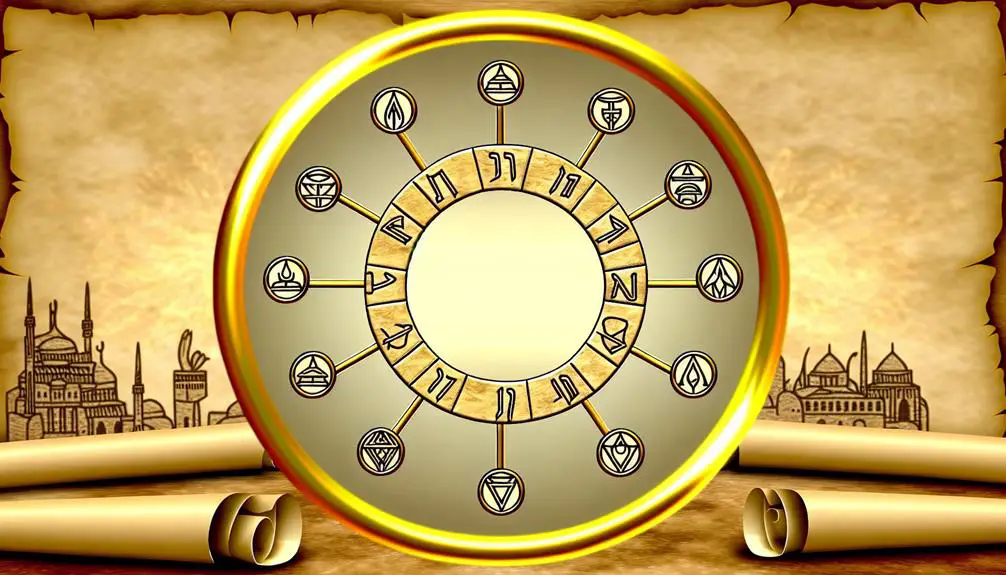Journey through the biblical months to uncover ancient wisdom and enduring practices that illuminate life's path today.

Months in the Bible
Exploring the months in the Bible is like uncovering layers of an ancient, forgotten map, each fold revealing secrets about times long passed yet profoundly relevant today.
You'll find that each month carries its unique significance, from Nisan's promise of redemption to Kislev's celebration of miracles.
As you journey through this biblical calendar, you'll discover how these ancient observations can offer insights into your own life, guiding your thoughts and actions throughout the year.
But where does this path lead, and how do these months connect with modern-day practices? You might be surprised by the depth and richness awaiting your discovery.
Key Takeaways
- Biblical months, like Nisan and Tishrei, align with significant religious and agricultural events, reflecting the lunisolar calendar's harmony.
- Nisan, associated with Passover, symbolizes themes of redemption, liberation, and natural renewal in spring.
- Other months, such as Iyar and Kislev, represent transitional periods and cultural celebrations, like healing and Hanukkah.
- The timing of biblical months guides the scheduling of key festivals, shaping communal identity and spiritual practices.
Biblical Calendar Overview

The biblical calendar, a critical aspect of ancient Hebrew life and liturgy, operates on a lunisolar system that intricately aligns with agricultural cycles and religious observances. You'll find that this calendar meticulously tracks lunar cycles, utilizing the moon's phases to mark the beginning and end of each month. This sophisticated method ensures that the calendar remains in harmony with the solar year, and crucially, aligns with key agricultural markers.
As you delve deeper, you'll understand that this alignment isn't coincidental but deeply embedded in the fabric of biblical teachings and practices. The synchronization of lunar cycles with agricultural markers is essential for determining the timing of sowing, harvesting, and festivals. This system, therefore, isn't just a method of timekeeping but a guide to life and worship, reflecting a profound connection between the divine, the natural world, and human activity.
Analyzing the biblical calendar reveals a complex layering of spiritual significance with practical daily life. It's a testament to how ancient cultures navigated their existence, intertwining their understanding of the cosmos with their agricultural practices, and embedding this knowledge within their spiritual and communal lives.
Nisan: Beginning of Redemption
As you explore Nisan, you'll uncover its pivotal role in the biblical narrative, marking the inception of redemption. This month is distinguished by Passover, the zenith of Nisan, commemorating the Exodus and embodying themes of liberation and renewal.
Furthermore, the arrival of spring during Nisan enriches these themes, intertwining natural rejuvenation with spiritual rebirth.
Nisan's Historical Significance
Delving into Nisan's historical significance reveals its role as the inception point of redemption in biblical narratives. This month, pivotal for its agricultural and royal connotations, serves as a backdrop to transformative events. Nisan agriculture marks a time of renewal and rebirth, aligning with themes of liberation. Conversely, royal edicts issued during Nisan have historically set the stage for monumental shifts, reflecting its importance in governance and divine intervention.
Aspect |
Significance |
|---|---|
Nisan Agriculture |
Marks renewal, aligning with redemption themes |
Royal Edicts |
Catalyst for significant historical shifts |
Biblical Narratives |
Inception point for tales of liberation |
Renewal and Rebirth |
Echoes in natural and spiritual realms |
Governance |
Reflects Nisan's role in divine plans |
Analyzing Nisan through these lenses offers a profound understanding of its pivotal role in biblical history and its enduring legacy as a symbol of redemption and new beginnings.
Passover: Nisan's Highlight
Exploring further into Nisan's significance, we find Passover standing prominently as the month's highlight, symbolizing the beginning of redemption in a vivid testament to historical and spiritual renewal. This pivotal event isn't just a cornerstone of Jewish faith but also provides a framework for understanding Easter's timing and significance in Christian traditions, illustrating a profound Easter comparison.
The interplay between Passover and Easter highlights the deep cultural influences these celebrations have on each other, reflecting shared themes of liberation, hope, and renewal across distinct religious landscapes. Such intersections underscore the broader impact of Passover beyond its immediate religious context, as it shapes and is shaped by varying cultural narratives, fostering a rich tapestry of spiritual reflection and communal identity across generations.
Springtime Renewal Themes
Nisan's arrival ushers in a season of springtime renewal, marking the beginning of redemption through a tapestry of historical and spiritual rejuvenation deeply rooted in biblical narratives. This period is significant for its embodiment of rebirth and regeneration, echoing the broader themes of freedom and salvation.
The connection between the biblical account of Nisan and contemporary celebrations can be explored through:
- Easter Origins: Tracing back to Passover, Easter embodies similar themes of deliverance and rebirth, highlighting the interwoven nature of Judeo-Christian observances.
- Spring Festivals: These events symbolize the awakening of the earth, mirroring the spiritual awakening and renewal that Nisan represents.
- Historical Celebrations: Festivities during Nisan often incorporate rituals that signify purification and the start of a new cycle, underscoring the month's role in spiritual and physical rejuvenation.
Iyar: Transition and Healing
In the biblical calendar, Iyar stands as a month symbolizing transition and healing, inviting you to delve deeper into its historical and spiritual significance. This period, nestled between the liberation themes of Passover and the revelation celebrated in Shavuot, offers a unique moment for reflection and growth. It's a time when the physical and spiritual landscapes are both in a state of flux, with spring allergies emerging as a tangible reminder of the season's change. These allergies, while a modern interpretation, can be seen as a metaphor for the challenges that accompany periods of transition.
Moreover, Iyar's connection to agricultural practices further underscores its theme of healing and renewal. In ancient times, this month was critical for managing crops and preparing for the harvest. The reliance on divine favor for rain and fertility highlights a deeper, spiritual aspect of healing and reliance on a higher power. It's a reminder that growth, both personal and communal, often requires patience, resilience, and faith.
As you explore Iyar's significance, consider how its themes of transition and healing resonate in your own life. Reflect on the ways in which you're called to nurture growth and navigate change, embracing the lessons this time offers.
Sivan: Receiving the Torah

In the Hebrew calendar, Sivan marks a pivotal juncture, as it's the month during which Jews commemorate the momentous event of receiving the Torah. This period's significance is deeply rooted in Judaism, serving as a foundational narrative for Jewish identity and religious practice.
Observances like Shavuot, celebrated within Sivan, underscore this connection through rituals that honor the Torah's revelation, highlighting its central role in guiding ethical and spiritual life.
Sivan's Significance in Judaism
Marking a pivotal moment within Judaism, Sivan's significance stems from the belief that it's the month the Torah was received by the Israelites on Mount Sinai. This event isn't just a historical marker; it shapes several Sivan customs and highlights its agricultural significance. Here's how:
- Sivan Customs: Practices such as studying Torah and engaging in communal prayers intensify, reflecting gratitude and reverence for the divine gift of guidance.
- Agricultural Significance: Sivan falls during a crucial time for crops in ancient Israel, linking the physical sustenance to spiritual nourishment received through the Torah.
- Intellectual Engagement: The focus on Torah study promotes a culture of learning and debate, fostering a community deeply connected by shared values and collective memory.
These elements underscore Sivan's profound role in embodying the unity between physical and spiritual realms in Judaism.
Torah Revelation Celebration
Celebrating the Torah's revelation during Sivan deeply enriches Judaism's spiritual landscape, anchoring communal and individual identities in the foundational moment of receiving divine guidance. This celebration isn't merely a remembrance but a dynamic engagement with the Torah origins, inviting continuous exploration and understanding. The act of receiving the Torah, as narrated in Jewish texts, isn't just historical; it's a living bridge connecting past, present, and future generations through shared values and ethical directives.
Revelation interpretations play a crucial role in this celebration, as they allow for the Torah's teachings to be contextualized and applied within contemporary life. Scholars and laypeople alike delve into the nuances of its commandments, stories, and wisdom, ensuring that the Torah remains a vibrant, guiding force in shaping moral and spiritual identity.
Shavuot Holiday Observances
Shavuot observances encapsulate the multifaceted nature of engaging with the Torah's reception, deeply intertwining ritual practices with profound theological reflections. This holiday not only commemorates the giving of the Torah at Mount Sinai but also celebrates the agricultural roots of ancient Israel. Here's how you navigate its complexities:
- Cheese traditions: You'll find that dairy foods, especially cheesecakes and blintzes, are prevalent. This custom possibly echoes the 'land flowing with milk and honey' or the new dietary laws received with the Torah.
- Agricultural roots: You acknowledge Shavuot's origins as a harvest festival, marking the wheat harvest in Israel. This aspect ties your spiritual celebrations to the land itself.
- Study sessions: Engage in all-night study sessions of Torah and rabbinic texts, reflecting on the enduring relationship between the divine and humanity through the covenant of the Torah.
Tammuz: Mourning and Fasting

In the Hebrew calendar, Tammuz is a period characterized by mourning and fasting, reflecting on the historical and religious calamities that befell the Jewish people. This month is deeply intertwined with ancient customs and seasonal references, marking a time of communal grief and individual reflection. The seventeenth day of Tammuz, in particular, commemorates the breach of Jerusalem's walls by the Babylonians, a prelude to the destruction of the Second Temple. This event ushers in a three-week period of mourning, culminating in the month of Av.
The practices observed during Tammuz are steeped in tradition, with fasting serving as a poignant expression of sorrow and solidarity. This fast isn't merely a physical abstention but a spiritual journey, encouraging introspection and renewal. The rituals performed are a testament to the resilience of faith amidst adversity, embodying a collective memory that spans millennia.
Seasonal references during Tammuz also highlight the agricultural calendar, where the onset of summer's heat affects both the natural and spiritual landscapes. This synchronicity between the physical and metaphysical underscores the holistic approach to time and existence in Jewish thought, where every season carries its own spiritual significance.
Av: Destruction and Hope
You'll find that Av encapsulates a pivotal juxtaposition in biblical narrative, marking both the destruction of the Temple and a period of profound hope.
This month's dual nature underscores the resilience and renewal inherent in the aftermath of ruin, highlighting a cycle of devastation and rebirth that's central to understanding its significance.
Temple Destruction Significance
Exploring the destruction of the Temple during Av reveals a profound interplay of despair and hope within the Jewish faith, embodying a dual narrative of loss and renewal. This period reflects not only a historical moment but also offers:
- Modern parallels, where communities face destruction yet find ways to rebuild and redefine their identity.
- Architectural significance, as the Temple's destruction symbolizes a profound loss of a central place of worship, prompting a reevaluation of spiritual practices and communal gathering spaces.
- Insights into the resilient spirit of a faith community that navigates the challenges of preserving tradition whilst adapting to contemporary realities.
Through this lens, the destruction becomes a catalyst for reflection on the enduring nature of belief and the capacity for renewal amidst adversity.
Av's Dual Nature
The month of Av embodies a profound dichotomy within Jewish history and faith, simultaneously symbolizing both the depths of despair and the peaks of hope. Av's climate, transitioning from the heat of summer to the onset of fall, mirrors this dual nature.
Aspect |
Despair |
Hope |
|---|---|---|
Av's Climate |
Harsh, dry conditions |
Precursor to nurturing rains |
Historical |
Destruction of Temples |
Promise of renewal and return |
Agricultural |
Challenging for crops |
Preparation for next planting |
This month's agricultural impacts are significant, as the harsh conditions test the resilience of both crops and people, yet also signal the impending rains that promise rejuvenation and growth. Av thus serves as a poignant reminder of life's cyclical nature, intertwining loss with renewal.
Renewal Amid Ruin
In examining Av's juxtaposition of destruction and hope, one quickly discerns how this month serves as a powerful symbol of rebirth amidst desolation. This period underscores:
- Personal Transformation: It's a time when you're encouraged to reflect on past misdeeds and strive for self-improvement. This inner change is foundational for moving forward.
- Societal Rebuilding: Following personal transformation, there's a collective effort towards rebuilding society. Av teaches that from the ashes of destruction, a more unified and stronger community can emerge.
- Renewed Faith: Amid the ruin, faith is often revitalized. This renewed spiritual connection fosters resilience and a hopeful outlook towards the future.
Analyzing Av, one finds a profound narrative of overcoming adversity through personal transformation and societal rebuilding, illuminating the path from ruin to renewal.
Elul: Reflection and Return
Marking the culmination of the Jewish year, Elul serves as a period for deep reflection and a return to spiritual roots, inviting you to engage in introspection and renewal. This month, rich in Elul customs, beckons you into a journey of spiritual preparation, laying the groundwork for the High Holy Days that follow.
During Elul, you're encouraged to undertake a rigorous self-examination, probing the depths of your soul and assessing your deeds over the past year. It's a time for seeking forgiveness, both from others and oneself, in a sincere attempt to mend relationships and purify the heart. The shofar's daily sounding acts as a clarion call, awakening you from spiritual slumber and nudging you towards repentance and self-improvement.
Moreover, the practice of reciting Psalm 27, a poignant plea for divine protection and guidance, becomes a daily ritual, encapsulating the essence of Elul's spiritual preparation. Its verses resonate with the themes of seeking closeness to God and expressing confidence in His salvation, mirroring the introspective and hopeful spirit of this sacred time.
As Elul unfolds, you're invited to delve into the rich tapestry of its customs, each designed to facilitate a return to one's spiritual essence and prepare the soul for the solemn introspection and jubilation that Tishrei brings.
Tishrei: Festivals of Renewal

With Tishrei, you enter a period rich in spiritual renewal and communal rejoicing, anchored by a series of significant Jewish festivals. This month is pivotal, not just for its religious observances but also for its deep agricultural significance, marking a time of both harvest and renewal. The observances in Tishrei serve as a profound reflection of faith, history, and the natural cycle of life.
- Rosh Hashanah celebrations – This festival initiates the Jewish New Year, embodying themes of judgment, remembrance, and the sounding of the shofar. It's a time for introspection and setting intentions for the year ahead. Rosh Hashanah's origins are tied closely to the agricultural calendar, marking the end of the harvest season and a time to pray for rain and a fruitful year.
- Yom Kippur – Occurring ten days after Rosh Hashanah, it's the Day of Atonement. It's the holiest day of the Jewish year, dedicated to repentance, prayer, and fasting. This day emphasizes spiritual renewal and purification.
- Sukkot – This week-long festival celebrates the gathering of the harvest and commemorates the Israelites' 40-year period of wandering in the desert. Sukkot involves dwelling in temporary shelters, highlighting the fragility of life and dependence on divine providence.
Tishrei's festivals encapsulate a blend of spiritual reflection, community bonding, and acknowledgment of the earth's bounty, making this month a cornerstone of Jewish life and faith.
Cheshvan: Quiet Contemplation
Following the spiritually rich observances of Tishrei, you'll find Cheshvan, a month distinguished by its quiet contemplation and absence of major religious festivals, offering a stark contrast and a period for reflection. This month's character is deeply intertwined with the anticipation of rain, a pivotal element in the biblical narrative due to its critical significance for agriculture in the ancient Near East.
Aspect |
Significance |
|---|---|
Rainfall |
Marks a prayer for sustenance and agricultural success |
Agricultural Cycle |
Transition from planting to growth phase |
Spiritual Reflection |
Time to internalize the lessons from Tishrei's holidays |
Community |
Unity in prayer for a prosperous year |
Environment |
Reminder of the dependence on natural resources |
In Cheshvan, the focus shifts from communal celebration to individual contemplation and prayer, particularly for rain, which is essential for the upcoming agricultural cycle. This month serves as a bridge, connecting the spiritual renewal of Tishrei with the practical concerns of daily life and sustenance. The absence of festivals isn't a void but a space filled with the silent prayers for rain, highlighting its agrarian society's reliance on divine favor for rainfall and agricultural impacts. The quiet of Cheshvan offers a moment to ponder the delicate balance between human effort and divine blessing in sustaining life.
Kislev: Miracles and Dedication

After the reflective period of Cheshvan, Kislev ushers in an era of celebration, focusing on miracles and dedication through the story of Hanukkah. This month is deeply intertwined with Hanukkah history and winter celebrations, highlighting a pivotal moment in Jewish faith and cultural identity.
Analyzing Kislev in the context of Hanukkah offers a multifaceted understanding of its significance:
- Historical Roots: Hanukkah commemorates the rededication of the Second Temple in Jerusalem, a story of resilience against oppression and the miracle of the oil that burned for eight days. This narrative, deeply embedded in Kislev, emphasizes the power of faith and the importance of commemorating liberation and miracles.
- Cultural Significance: Beyond its religious implications, Kislev and Hanukkah play a vital role in Jewish cultural identity, offering a time for family gatherings, traditions, and the spreading of light during the darkest days of winter.
- Spiritual Reflection: Kislev encourages introspection on the themes of dedication, light, and miracles. It's a time to reflect on personal and communal commitments to faith, justice, and kindness in the face of adversity.
In essence, Kislev embodies the spirit of Hanukkah, weaving together historical events, cultural practices, and spiritual lessons that resonate through winter celebrations.
Frequently Asked Questions
How Do the Months in the Biblical Calendar Align With or Differ From the Modern Gregorian Calendar Months?
The biblical calendar doesn't align neatly with the Gregorian calendar. You'll find differences in leap years and month names.
The Gregorian leap years add a day every four years, a concept absent in the biblical system. Also, Gregorian month names have Roman origins, while biblical months draw from ancient cultures and agriculture.
This mismatch highlights a fascinating divergence in how we've historically conceptualized and measured time, reflecting changes in cultural and religious practices.
Are There Any Specific Rituals or Practices That Modern Believers Perform in Relation to the Biblical Months Outside of Those Mentioned in the Article?
You might think modern adaptations of biblical month rituals are as rare as unicorns, but they're quite prevalent.
Many believers follow practices with deep cultural significance, connecting them to ancient traditions. These activities, though not explicitly mentioned in the article, range from fasting to feasting, reflecting on the past, and setting intentions for the future.
Each act is imbued with a rich tapestry of meaning, skillfully blending historical reverence with contemporary spirituality.
How Do Biblical Months Influence Jewish Holidays That Are Not Directly Tied to the Agricultural Cycle, Such as Purim or Hanukkah?
You'll find that Jewish holidays like Purim and Hanukkah, though not directly tied to the agricultural cycle, are deeply influenced by moon phases. The lunar calendar dictates their timing, aligning spiritual observance with celestial movements.
For example, Purim celebrates Esther's bravery in saving her people, and its date is determined by the moon, reminding us of the constant interplay between our calendar and the cosmos, enriching these observances with a layer of cosmic symbolism.
What Role Did the Biblical Months Play in the Daily Lives of Ancient Israelites Beyond Religious Observances?
You'll find that the agricultural impact and social structure of ancient Israelites were deeply intertwined with the calendar. Beyond religious observances, the months dictated the agricultural activities, from planting to harvest, shaping daily life and labor.
This cyclical nature reinforced the social structure, as communal events and responsibilities were organized around these agricultural milestones, fostering a strong sense of community and shared purpose among the populace.
How Have Interpretations or Celebrations of These Biblical Months Evolved Within Different Jewish Communities Around the World?
You'll find the calendar's tapestry richly woven with cultural adaptations and geographic variations. Communities worldwide have embraced these ancient timekeepers, infusing each month with unique interpretations and celebrations.
This evolution reflects the diverse ways Jewish communities honor their heritage while adapting to their environments. From the lively streets of Jerusalem to the quiet corners of the Diaspora, each community adds its own detailed, analytical stitch to this scholarly quilt.
Conclusion
In sum, the biblical calendar isn't merely a sequence of months; it's a profound journey of the spirit. From Nisan's heralding of redemption to Kislev's celebration of divine interventions, each period encapsulates a distinct phase in the soul's annual pilgrimage.
This cyclical odyssey, replete with moments of introspection, mourning, and jubilation, mirrors the multifaceted human experience. Thus, these tempos of time don't just pass; they sculpt, refine, and elevate the human condition, guiding believers through a meticulously designed spiritual landscape.



Sign up